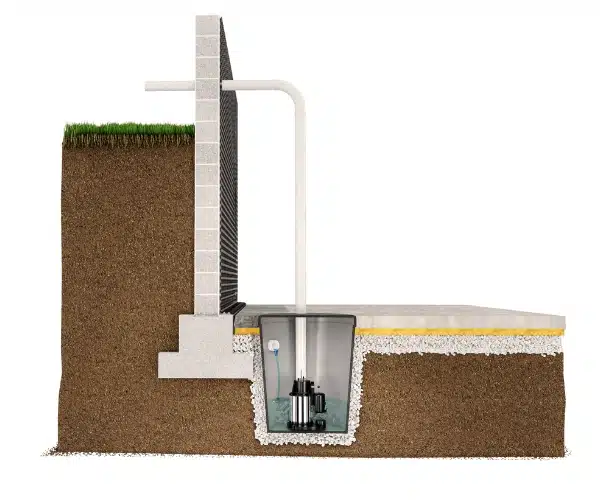If you live in areas prone to flooding, you know how important it is to have a reliable sump pump system in your home’s basement or crawl space.
But what exactly is a sump pump, and how does it work? We’ll explain everything you need to know about sump pumps, from how they’re used to protect your home from water intrusion and flooding to the different types of systems available. Whether you’re considering installing one or want to be informed about how they work, read on for all the essential information.
What Is A Sump Pump System, And How Does It Work?
A sump pump system is a primary pump used to protect homes from groundwater, the primary element of a basement waterproofing system in which groundwater is collected and guided out and away from the home.

It is a subterranean basin, often constructed of concrete or plastic, known as a sump pit. This pit collects groundwater seepage, and within it resides the sump pump—a device dedicated to redirecting accumulated water away from the house to prevent water infiltration into foundations, basements, or crawl spaces.
Sump pits usually have dimensions of 2 feet in depth and 18 inches in diameter. They are equipped with a floating switch that activates the pump when the water reaches a certain level. This system often incorporates a one-way check valve to prevent water from flowing back into the pit, and some may include alarms for phone alerts. Since sump pumps require electricity to operate and it function close to or within the water, it is crucial to ensure that the outlet to which the pump is connected has a ground fault circuit interrupter (GFCI).
Components of Sump Pump System

Primary Pump: The primary component of a sump pump system is the pump itself, which is responsible for collecting and transferring the water away from your home or business. This pump typically consists of an inlet, impeller, motor, and outlet pipe. The inlet is designed to draw water from the sump pit and the impeller.
Check Valve: The check valve is a critical component of the sump pump system that prevents water from flowing back into your home or business. It is installed in the discharge pipe between the primary pump and the outlet, ensuring that no water can flow backward once it has been pumped out.
Discharge Line: The discharge line is the pipe that connects the sump pump to the outside of your home or business. It serves as the conduit for water to be pumped away from the foundation and out of the building. Proper sizing and installation of this component is critical – it should be of adequate diameter, pitched at a correct angle, and free of any cracks or leaks that could cause flooding.
Backup Pump System: Depending on the location of your property and local codes, a backup pump system may be required or optional. This secondary pump is designed to kick in if the primary fails and helps ensure that there is no disruption in service during power outages or other emergencies.
Monitoring System: An optional monitoring system can be installed to alert you if your sump pump is not working as it should. This device typically consists of a float switch, which will trigger an alarm in case of a malfunction or other problem with your sump pump system.
Basin and Basin Lid: The basin is the container where your sump pump system is located. This component should be large enough to hold any water that may accumulate, and it must have a secure lid to prevent clogging or other problems.
Discharge Outlet: The discharge outlet is an opening through which the water collected by the sump pump is pumped out. It should be at least 10 feet away from the house and have a proper fitting to prevent flooding.
Types of Sump Pumps
Choosing the appropriate pump for your home is a crucial decision. We will discuss the distinctions among various sump pumps and help you determine which one may be the best fit for your basement or crawl space. They are categorized into two main types: primary and backup, and it’s recommended to have both in your setup.
Primary Sump Pump
The primary sump pump manages most of the workload of regularly removing groundwater that flows underground to maintain a dry environment in your home. Various types of primary pumps are available, and we will explore a few of them.
Submersible Sump Pump
A submersible sump pump is a primary pump that is a relatively large device that is positioned directly inside the sump pit and operates while submerged underwater, hence the term “submersible.” Because it is situated within the pit, this pump tends to operate more quietly than pedestal pumps.
However, they often come with a higher price tag and are more challenging to reach for maintenance purposes due to their location within the pit.
Pedestal Sump Pump
Unlike a submersible pump, the motor of a pedestal pump is not designed to be submerged in water. This pump is more cost-effective and simpler to reach for maintenance compared to submersible pumps. However, the pedestal pump is noisier since its motor is above the sump pit.
Back-Up Sump Pump
The backup pumps stand ready to take over if the primary pump malfunctions or a power outage disrupts its operation. There are several options available:
Battery-Operated Backup Sump Pump
Sump pumps rely on electricity, making them ineffective during power outages, particularly in stormy conditions when their operation is crucial.
To address this vulnerability, it is advisable to have a battery backup sump pump that guarantees it will continue functioning even without the main power. Activated when water levels rise in the sump chamber and the primary pump fails, the battery backup pump automatically kicks into action. It efficiently pumps water out of the property, ensuring ongoing protection against potential flooding.
Water-Powered Backup Sump Pump
Water-powered pumps operate without electricity, relying on traditional water pressure for unlimited runtime. However, they demand a strong and steady water flow, typically from a high-pressure city water system.
Homes with low water pressure or well-powered system may experience challenges with these pumps. Furthermore, their installation is more complex compared to battery-powered alternatives.
How to Choose The Right Sump Pump System For Your Home
Choosing the right sump pump system for your home can be a daunting task. Before making a purchase decision, there are several factors you should consider.
- Pump Capacity and Power
It’s critical to choose a sump pump that can manage the water intake of your specific home size. Be sure to consider the flow rate or a system that can process at least 10 gallons per minute (GPM) with a peak horsepower rating of 0.5 as a key indicator of a pump’s capacity.
It is also essential to ensure it has enough discharge power to pump the water away from your home quickly and efficiently. - Float Switch Options
Different float switch designs are available, the most common being the tether float and vertical switch. Each has its benefits, but the choice often comes down to the depth of your sump pit and personal preference. - Maintenance Requirements
While a sump pump can be a “fit and forget” installation, regular checks on the system, especially before wet seasons, can be the difference between a dry basement and a costly cleanup. - Water Volume Assessment
Determine the amount of water to be pumped, as this will help determine what grade of pump system you should get. Additionally, you must consider where you plan on locating the sump pump in your home so that it can efficiently remove water away from your house. - Geographic Climate
A bigger capacity pump may be necessary if you are located in an area prone to heavy rains or snowfall. - Durability
Invest in a durable system with a reliable motor. Quality materials and construction contribute to the long-term effectiveness of your sump pump.
Considering all these things will ensure you get the right sump pump system for your home and keep things dry inside.
How to Maintain Your Sump Pump System
Maintaining your sump pump system is essential to a dry basement or crawl space and peace of mind. Here are some tips to consider.
- Avoid sump pump failure by conducting annual cleaning and replacing the check valve. This routine maintenance helps prevent clogs and ensures smooth operation.
- Flush the sump pump system with water every 1-2 years to clear debris and sediment, maintaining optimal performance. This step helps prevent blockages and enhances the longevity of the system.
- Replace the battery on backup pumps every 1-3 years to guarantee seamless operation during power outages. This proactive measure ensures that the backup pump can function without delay when needed.
- Periodically check for any leaks or disconnections in the pipes connected to the sump pump system. Promptly reseal any identified issues to prevent water damage and maintain the system’s effectiveness.
Taking preventative measures consistently will ensure that your sump pump system stays working at its best for many years to come. If you need help in the selection or sump pump installation, contact the LUX team. We would happily help you determine the best options for your home or business.
How to Test Your Sump Pump System
Testing your sump pump system is important in maintenance. It can help you identify potential issues before they become big problems and ensure it operates effectively when needed most.
- Ensure all power sources are correctly connected before testing your sump pump system.
- Turn on the sump pump switch and observe its response.
- Check for any blockages in the pipes and promptly remove them if necessary.
- Pour a few gallons of water into the pit until it reaches the operating level.
- The primary sump pump should activate within 10-15 seconds. If not, inspect components like the float switch and power source.
- If a backup pump is present, verify that it activates after a designated time and effectively pumps out water.
- Inspect all components for signs of wear or damage and replace them as needed.
Invest in a Reliable Sump Pump System Today!
Protect your home against water damage with a sump pump system. At LUX Foundation Solutions, we are ready to provide personalized guidance on selection and sump pump installation tailored to your specific needs. With decades of experience, LUX experts understand Virginia’s challenging expansive clay soil.
Ready to safeguard your home from potential flooding? Contact the LUX team at 540-508-8587 or fill out our online estimate request form for personalized guidance on selection and sump pump installation in Northern Virginia, Shenandoah Valley, North Central Virginia, West Virginia, and surrounding areas.
FAQ’s
Common Questions About Sump Pumps
Why do I need a sump pump in Northern Virginia?
A sump pump is crucial in safeguarding your home to prevent water damage, particularly in regions like Northern Virginia that are susceptible to heavy rainfall and high water tables. It ensures your property remains dry and protected by efficiently managing excessive groundwater and preventing flooding.
To understand how a sump pump can benefit your situation, contact the experts at LUX Foundation Solutions. We’re here to provide tailored solutions for your Northern Virginia home.
Do I need a backup sump pump?
Yes, it is highly advisable to have a backup sump pump, especially in areas like West Virginia. It is typically powered by a battery, ensuring continued functionality during power outages or instances when the primary pump may fail. This additional layer of protection offers peace of mind, safeguarding your property against potential flooding and water damage.
For personalized advice on choosing the right backup sump pump for your needs, contact our experts at LUX Foundation Solutions.
How do I test my sump pump?
To ensure the effectiveness of your sump pump, follow these simple steps:
1. Clear the pit of any debris to allow for unobstructed operation.
2. Pour water into the pit to raise the float switch, simulating rising water levels.
3. Confirm that the pump activates promptly and efficiently pumping water out of the pit.
4. Check the float switch for any obstructions or issues that may impede its function.
5. Repeat this test periodically to guarantee the ongoing proper function of your sump pump.
Should any issues arise during testing or if you have concerns about your crawl space or basement sump pump’s performance, contact LUX Foundation Solutions. Our experts are ready to conduct inspections and provide any necessary repairs, ensuring it is always in top-notch condition.
What size sump pump do I need for my home in Shenandoah Valley?
The crawl space or basement sump pump size required for your home in Shenandoah Valley depends on various factors, including the size of your basement or crawl space, the volume of water inflow, and the specific climate conditions in the region.
To determine the most suitable size for your needs, we recommend contacting our experts at LUX Foundation Solutions. Our team can assess your unique requirements and provide personalized guidance to ensure optimal protection against potential flooding. Contact us today for reliable advice tailored to your Shenandoah Valley home.
Can I install a sump pump myself?
While some homeowners may feel confident handling basic installations, it’s crucial to note that installing a sump pump involves technical aspects that influence its effectiveness. We strongly recommend hiring a professional to ensure safe and proper setup and compliance with local building codes.
Professional installation guarantees correct installation and ensures that it functions optimally, providing the best protection against potential water damage. If you have any questions or need assistance, contact our LUX Foundation Solutions team.
How long does a sump pump last?
The lifespan of a sump pump can vary, but with proper maintenance, you can expect it to last around 10 years on average. Regular checks and promptly addressing any issues can significantly extend its longevity. Ensuring that it is well-maintained is key to its optimal performance.
If you have any concerns or need assistance with sump pump maintenance, contact the experts at LUX Foundation Solutions. We’re here to help you keep your sump pump in top condition for years to come.
